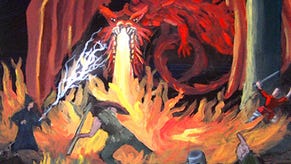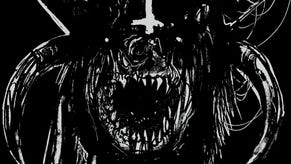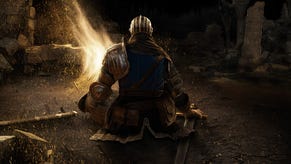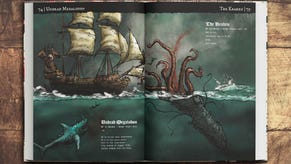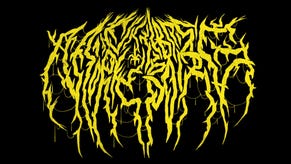From Kingdom Death to Mörk Borg, modern tabletop gaming owes a huge debt to Kentaro Miura and Berserk
Blood and Guts.
It was with great sadness that the world learned of the death of Kentaro Miura, at 54. The mangaka was best known for Berserk, his life's work, a dark fantasy story that follows protagonist Guts and the exploits of the Band of the Hawk. Grim warriors with complex histories survive in a world of untold horrors, towering castles and grand martial battles between good and evil; Berserk treads much of the same ground as modern tabletop games, and its influence is undeniable.
Berserk is a singular work of great genius that began 32 years ago. Miura was penning early versions in his teens whilst working as an assistant under Hajime No Ippoo author Jyoji Morikawa. Shortly after, Berserk began serialisation, and chapters were still being released into 2021. Throughout this time Miura's artwork has remained peerless, his illustrations able to convey tapestries of incredible violence and agony, rendering worlds shifting and bending to the will of dark, supernatural forces beyond the ken of mortals, whilst also effortlessly portraying moments of great tenderness and quiet contentment.
Berserk casts a long shadow over all contemporary fantasy. For many, it is too raw, dealing with sexual abuse, irredeemable violence and the blind pursuit of revenge. But, as Miura matured, Berserk matured with him, and its message of an endless struggle seemed to reflect his own pursuit for perfection, found within immaculately penned pages of splendour and horror.
Berserk casts a long shadow over all contemporary fantasy.
For those of us that play tabletop games, be they RPGs, miniatures games or board games, the influence of Miura's lifework is inescapable. As a fan of fantasy, discovering Berserk is often akin to a shot of adrenaline, jolting life into a genre that can often feel rote and tiring at times. Berserk was bloody and bold, and had a sense of vastness and scale that sucked readers in.
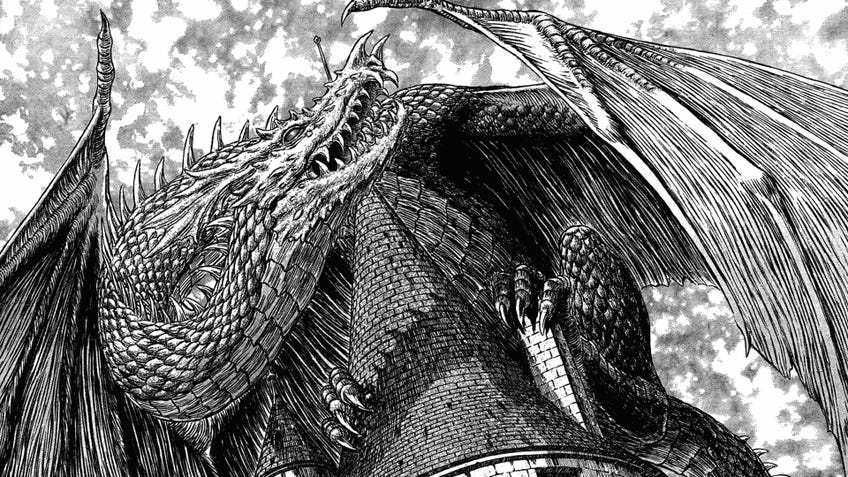
Fantasy in general has witnessed a renaissance of late, with Dungeons & Dragons 5E being the system's most popular entry, endorsed by celebrities and with games by collectives such as Critical Role played to audiences of millions on Twitch. But where did all of these players come from? Whilst George RR Martin's Game of Thrones can easily be pointed at as the catalyst for fantasy’s re-acceptance by the mainstream in the post-Lord of the Rings years, video games were already working on popularising the genre among a wider audience.
If ever a series of games owed Miura and Berserk a heavy debt, it is surely Dark Souls. Developer FromSoftware does not shy away from its influences - Guts’ iconic Dragon Slayer blade appears multiple times. The simultaneously regal yet decaying beauty of Dark Souls, with its oppressive cyclopean architecture and worlds rotting under eclipses, is Berserk writ large in digital. It's no stretch to say that without Miura, Dark Souls may not even exist. The cross-pollination between video games and board games thanks to Kickstarter has since seen the titles appear on the tabletop, a natural fit alongside stalwarts such as D&D and Pathfinder.
More obvious influence can be seen in games such as Kingdom Death: Monster. The miniatures seem to have leapt right from the pages of Berserk’s darkest moments, with grotesque Hieronymus Bosch-esque demons and monsters made of hideous oversized faces and crude, grasping hands found leering lasciviously at readers and players alike.
Kingdom Death: Monster's miniatures seem to have leapt right from the pages of Berserk’s darkest moments.
Whilst Warhammer Fantasy was already well underway whilst Miura was just starting Berserk, the two seem in many ways inextricably linked. Early Games Workshop artists such as John Blanche, Wayne England and Adrian Smith wouldn't look out of place lined up next to panels from Miura's masterwork; the use of light and dark, scratchy impressionist strokes and endless, infinitesimal details crop up in all of their work.

It is perhaps no surprise then that the Warhammer community has created collaborative projects such as Ex Profundis, Iron Sleet, the Dark Age of Sigmar, and The Pilgrym - collective works that lean away from the clean, bold colours of Games Workshop's ‘Eavy Metal team and into the oily, textural mess typified by Miura's dark fantasy worlds.
Creators such as Pegastyx and ingrimmson produce works of brutal, baroque provenance that feel like they're of the same cloth as Berserk. Elsewhere, 3D printing on demand and cheaper resin printing have let companies such as Creature Caster and Mierce Miniatures cleave closer to overly-detailed, morbid fantasy, away from more mainstream releases.
The eruption of the OSR scene in tabletop roleplaying also feels like it tugs on the same strings as Berserk, with Mörk Borg's use of religious woodcuts, apocalyptic imagery and the horror of the struggle against the inevitable end bringing a particular brand of dark fantasy to the table. Whilst Mörk Borg and other OSR games originate in the old-school brutality of Gygax-era D&D, they are also forged in the same crucible of bleak, heavy metal fantasy that birthed Berserk. At times, the mismatched group that Guts travels with in the second half of the manga looks every bit the quintessential D&D party.
The mismatched group that Guts travels with in the manga looks every bit the quintessential D&D party.
I would doubt that any of these works would quote Berserk as a singular influence but, like the eclipse that its story rests on like a wicked fulcrum, Berserk is all-consuming. The image of Guts, the lone swordsman brandishing a weapon much too big to be called a sword, transcends the manga. Whether people know it or not, Miura's work has undeniably seeped into the cultural consciousness that has given birth to so much dark fantasy art since.
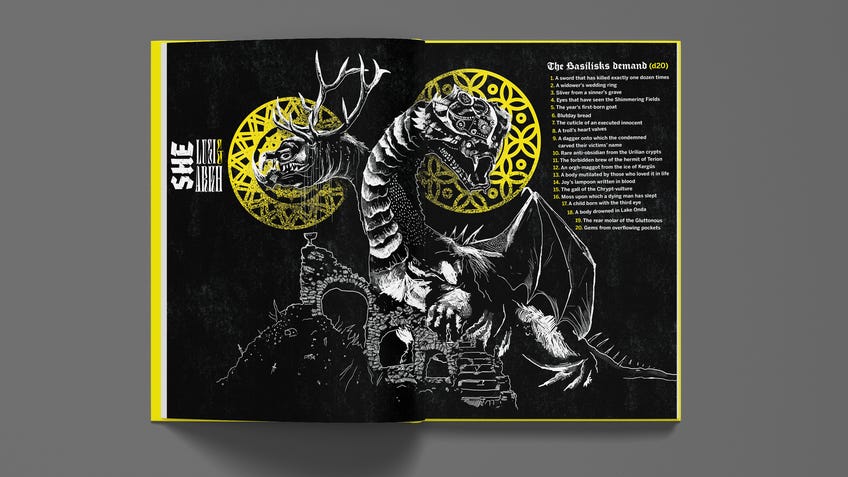
For me, he made fantasy exciting again and, perhaps most importantly for a work that started off covering the grimmest parts of fantasy for their shock value, created a story of redemption, vengeance and violence that had a real heart. At times, that heart was pitch black and hard to behold, but at others it fluttered lightly and with warmth. Every moment was earned with resolute conviction. Even though it may now never be finished, Berserk had reached a point where revenge was traded for redemption and hope shone eternal at its core - even if it was mired in blood and grime. Many characters may never get the ending they deserve, but life is never so simple.
Berserk remains unfinished due to the fact that Kentaro Miura was a perfectionist. He penned many agonising panels of wondrous beauty, and created a fantasy world the likes of which you can find reflected in the darkest parts of modern tabletop RPGs, board games and miniatures games. Whilst his untimely death is an absolute tragedy, it also serves as a time to look back on his work and his towering influence, and to understand that no matter how hard the struggle may be at times just to live, no matter how long the journey and how uncertain the end, it is always worth it.



